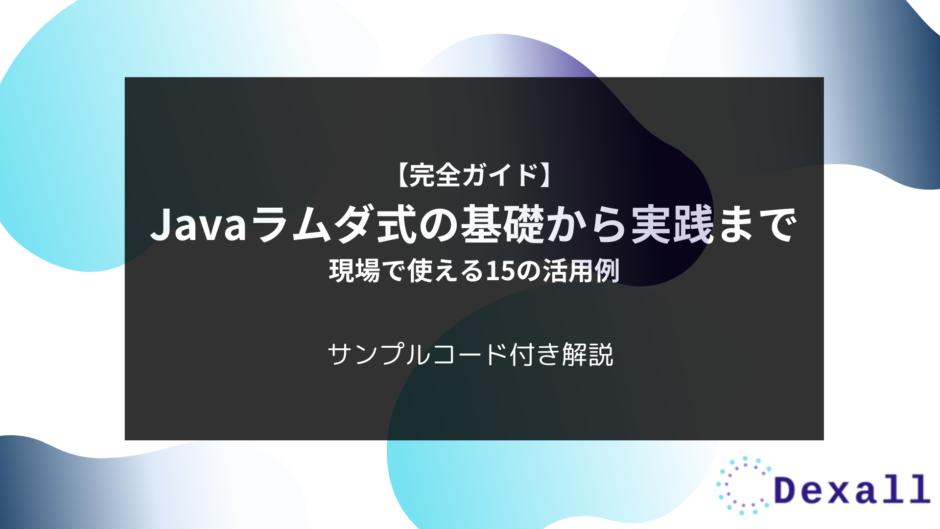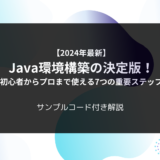はじめに
Javaのラムダ式は、Java 8で導入された機能で、コードをより簡潔に、読みやすく、そして保守性が高い形で書くことを可能にします。この記事では、ラムダ式の基礎から実践的な使用方法まで、現場のエンジニアが即座に活用できる形で解説します。
- ラムダ式の基本概念と構文
- 実践的な使用パターンと具体例
- Stream APIとの効果的な組み合わせ方
- パフォーマンスとデバッグのベストプラクティス
- 発展的な使用方法と応用テクニック
それでは、Javaラムダ式の世界を詳しく見ていきましょう。
1.Javaラムダ式とは?初心者にもわかる基礎解説
1.1 ラムダ式が生まれた背景と重要性
Javaのラムダ式は、Java 8で導入された革新的な機能で、より簡潔で読みやすいコードを書くための強力なツールです。
- 関数型プログラミングの需要増加
- 並列処理やマルチコア処理の効率化
- コードの可読性と保守性の向上
- モダンなプログラミング手法の採用
- コードの簡素化:短く簡潔な記述が可能
- 可読性の向上:意図が明確に伝わる
- Stream APIとの相性:データ処理が効率的に
- 保守性の向上:コード量の削減により、バグの可能性も低下
1.2 従来の匿名クラスとの違い
従来の匿名クラスとラムダ式を比較してみましょう。
従来の記述方法(匿名クラス):
// ボタンクリックのイベントハンドラ
button.addActionListener(new ActionListener() {
@Override
public void actionPerformed(ActionEvent e) {
System.out.println("ボタンがクリックされました");
}
});
// リストのソート処理
Collections.sort(list, new Comparator<String>() {
@Override
public int compare(String s1, String s2) {
return s1.compareTo(s2);
}
});
ラムダ式での記述:
// ボタンクリックのイベントハンドラ
button.addActionListener(e -> System.out.println("ボタンがクリックされました"));
// リストのソート処理
Collections.sort(list, (s1, s2) -> s1.compareTo(s2));
1.3 ラムダ式の基本構文と書き方のルール
ラムダ式は以下の基本構文に従います。
(パラメータ) -> { 処理内容 }
基本的なルール:
1. パラメータが1つの場合
// 括弧を省略可能 x -> x * x
2. パラメータが複数の場合
// 括弧が必要 (x, y) -> x + y
3. 処理が1行の場合
// 波括弧とreturnを省略可能 (x, y) -> x + y
4. 処理が複数行の場合
(x, y) -> {
System.out.println("計算開始");
return x + y;
}
型推論の活用:
// パラメータの型を明示的に指定 (String s) -> s.length() // 型推論を利用(推奨) s -> s.length()
よく使用される形式:
| 形式 | 例 | 用途 |
|---|---|---|
| 引数なし | () -> System.out.println(“Hello”) | Runnableなど |
| 引数1つ | x -> x * 2 | UnaryOperatorなど |
| 引数2つ | (x, y) -> x + y | BinaryOperatorなど |
| 複数処理 | x -> { x++; return x; } | 複雑な処理 |
これらの基本を押さえることで、ラムダ式を効果的に活用できるようになります。次のセクションでは、より具体的な使用例を見ていきましょう。
2.ラムダ式の基本的な使い方と具体例
2.1 Comparatorでのソート処理の簡略化
Comparatorインターフェースを使用したソート処理は、ラムダ式の最も一般的な使用例の1つです。
従来の方法とラムダ式の比較:
// サンプルのPersonクラス
public class Person {
private String name;
private int age;
// コンストラクタ、getter、setterは省略
}
// 従来の方法
List<Person> people = new ArrayList<>();
Collections.sort(people, new Comparator<Person>() {
@Override
public int compare(Person p1, Person p2) {
return p1.getAge() - p2.getAge();
}
});
// ラムダ式を使用
// 年齢でソート
Collections.sort(people, (p1, p2) -> p1.getAge() - p2.getAge());
// 名前でソート
Collections.sort(people, (p1, p2) -> p1.getName().compareTo(p2.getName()));
// 複数条件でソート
Collections.sort(people, (p1, p2) -> {
int nameCompare = p1.getName().compareTo(p2.getName());
return nameCompare != 0 ? nameCompare : p1.getAge() - p2.getAge();
});
2.2 Runnableインターフェースでの実装例
マルチスレッドプログラミングでよく使用されるRunnableインターフェースの実装も、ラムダ式で簡潔に書けます。
// 従来の方法
Thread thread1 = new Thread(new Runnable() {
@Override
public void run() {
System.out.println("従来の方法による処理実行");
}
});
// ラムダ式を使用した方法
Thread thread2 = new Thread(() -> System.out.println("ラムダ式による処理実行"));
// 複数の処理を含む場合
Thread thread3 = new Thread(() -> {
System.out.println("処理開始");
// 重い処理を想定
try {
Thread.sleep(1000);
} catch (InterruptedException e) {
e.printStackTrace();
}
System.out.println("処理完了");
});
// 実行例
thread1.start();
thread2.start();
thread3.start();
2.3 ActionListenerでのイベント処理
GUIアプリケーションでのイベント処理も、ラムダ式で簡潔に記述できます。
import javax.swing.*;
import java.awt.event.*;
public class EventHandlingExample {
public static void main(String[] args) {
JFrame frame = new JFrame("イベント処理の例");
JButton button = new JButton("クリックしてください");
// 従来の方法
button.addActionListener(new ActionListener() {
@Override
public void actionPerformed(ActionEvent e) {
System.out.println("ボタンがクリックされました");
}
});
// ラムダ式を使用
button.addActionListener(e -> System.out.println("ボタンがクリックされました"));
// より複雑な処理の例
button.addActionListener(e -> {
System.out.println("処理開始");
// ボタンの状態を変更
JButton sourceButton = (JButton)e.getSource();
sourceButton.setEnabled(false);
sourceButton.setText("処理中...");
// 一定時間後に元に戻す
new Timer(2000, evt -> {
sourceButton.setEnabled(true);
sourceButton.setText("クリックしてください");
}).start();
});
}
}
実践的なポイント:
| 使用場面 | ラムダ式の利点 | 注意点 |
|---|---|---|
| ソート処理 | コードの簡潔さ、可読性向上 | 複雑な比較ロジックは分離を検討 |
| スレッド処理 | 簡潔な記述、即座の理解が可能 | 例外処理の適切な実装が必要 |
| イベント処理 | コード量の削減、見通しの良さ | 複雑な処理は別メソッドへの切り出しを推奨 |
これらの例は、ラムダ式が実際のコードでどのように使用され、どのような利点をもたらすかを示しています。次のセクションでは、より高度な使用方法としてStream APIとの組み合わせを見ていきましょう。
3.StreamAPIと組み合わせた実践的な活用法
3.1 filter()でのデータ絞り込み
Stream APIのfilter()メソッドは、コレクション内のデータを条件に基づいて絞り込む際に非常に効果的です。
// サンプルのProductクラス
public class Product {
private String name;
private int price;
private String category;
public Product(String name, int price, String category) {
this.name = name;
this.price = price;
this.category = category;
}
// getter, setterは省略
}
// 商品リストの作成
List<Product> products = Arrays.asList(
new Product("ノートPC", 80000, "電化製品"),
new Product("コーヒーメーカー", 5000, "キッチン"),
new Product("スマートフォン", 60000, "電化製品"),
new Product("デスクチェア", 12000, "家具")
);
// 単一条件での絞り込み
List<Product> expensiveProducts = products.stream()
.filter(p -> p.getPrice() > 50000)
.collect(Collectors.toList());
// 複数条件での絞り込み
List<Product> targetProducts = products.stream()
.filter(p -> p.getPrice() > 10000)
.filter(p -> p.getCategory().equals("電化製品"))
.collect(Collectors.toList());
// より複雑な条件での絞り込み
List<Product> customProducts = products.stream()
.filter(p -> {
boolean isPriceInRange = p.getPrice() >= 5000 && p.getPrice() <= 70000;
boolean isValidCategory = Arrays.asList("電化製品", "家具").contains(p.getCategory());
return isPriceInRange && isValidCategory;
})
.collect(Collectors.toList());
3.2 map()での要素の変換
map()メソッドを使用すると、ストリーム内の要素を別の形式に変換できます。
// 商品名のリストを取得
List<String> productNames = products.stream()
.map(Product::getName) // メソッド参照を使用
.collect(Collectors.toList());
// 価格に消費税を追加した新しいProductオブジェクトを生成
List<Product> productsWithTax = products.stream()
.map(p -> new Product(
p.getName(),
(int)(p.getPrice() * 1.1), // 10%の消費税を追加
p.getCategory()
))
.collect(Collectors.toList());
// 複数の変換を組み合わせる
List<String> formattedProducts = products.stream()
.map(p -> {
String priceString = String.format("%,d円", p.getPrice());
return String.format("%s (%s) - %s",
p.getName(), p.getCategory(), priceString);
})
.collect(Collectors.toList());
3.3 collect()を使ったデータの集計
collect()メソッドを使用することで、様々な方法でデータを集計できます。
// カテゴリごとの商品数をカウント
Map<String, Long> categoryCount = products.stream()
.collect(Collectors.groupingBy(
Product::getCategory,
Collectors.counting()
));
// カテゴリごとの平均価格を計算
Map<String, Double> avgPriceByCategory = products.stream()
.collect(Collectors.groupingBy(
Product::getCategory,
Collectors.averagingInt(Product::getPrice)
));
// より複雑な集計例
Map<String, Map<String, List<Product>>> complexGrouping = products.stream()
.collect(Collectors.groupingBy(
Product::getCategory,
Collectors.groupingBy(p -> {
if (p.getPrice() < 10000) return "低価格";
if (p.getPrice() < 50000) return "中価格";
return "高価格";
})
));
// 統計情報の取得
DoubleSummaryStatistics priceStats = products.stream()
.collect(Collectors.summarizingDouble(Product::getPrice));
System.out.println("価格の統計:");
System.out.println("平均: " + priceStats.getAverage());
System.out.println("最大: " + priceStats.getMax());
System.out.println("最小: " + priceStats.getMin());
System.out.println("合計: " + priceStats.getSum());
実践的な使用パターン一覧:
| 操作 | メソッド | 一般的な使用例 |
|---|---|---|
| 絞り込み | filter() | データの検索、条件に合う要素の抽出 |
| 変換 | map() | DTOへの変換、データ形式の変更 |
| 集計 | collect() | グループ化、統計情報の収集 |
パフォーマンスに関する注意点:
- 大量データを処理する場合は
parallel()の使用を検討 - 中間操作は遅延評価されるため、必要な操作のみを行う
- 複雑な処理は別メソッドに分離して可読性を確保
次のセクションでは、より実践的なラムダ式のパターンについて見ていきましょう。
4.現場で使える実践的なラムダ式パターン10選
4.1 Optional型との組み合わせによるNullチェックの簡略化
Optional型とラムダ式を組み合わせることで、より安全で読みやすいコードが書けます。
// ユーザー情報を扱うクラスの例
public class User {
private String name;
private String email;
private Address address;
// getter, setterは省略
}
public class Address {
private String city;
private String street;
// getter, setterは省略
}
// パターン1: 安全なnullチェックチェーン
Optional.ofNullable(user)
.map(User::getAddress)
.map(Address::getCity)
.orElse("住所不明");
// パターン2: 条件付き処理
Optional.ofNullable(user)
.filter(u -> u.getEmail() != null)
.ifPresent(u -> sendEmail(u.getEmail()));
// パターン3: 代替値の提供
String userCity = Optional.ofNullable(user)
.map(User::getAddress)
.map(Address::getCity)
.orElseGet(() -> {
log.warn("住所が見つかりません");
return "未設定";
});
// パターン4: 例外ハンドリング
User validUser = Optional.ofNullable(user)
.orElseThrow(() -> new UserNotFoundException("ユーザーが存在しません"));
4.2 並列処理での活用方法
並列処理においてラムダ式を活用することで、簡潔で効率的な実装が可能になります。
// パターン5: 並列ストリーム処理
List<Integer> numbers = Arrays.asList(1, 2, 3, 4, 5, 6, 7, 8, 9, 10);
int sum = numbers.parallelStream()
.filter(n -> n % 2 == 0)
.mapToInt(n -> {
// 重い処理を想定
try {
Thread.sleep(100);
} catch (InterruptedException e) {
Thread.currentThread().interrupt();
}
return n * 2;
})
.sum();
// パターン6: CompletableFutureでの非同期処理
CompletableFuture<String> future = CompletableFuture
.supplyAsync(() -> "データの取得")
.thenApplyAsync(data -> {
// データの加工処理
return data + "の処理完了";
})
.thenApply(result -> {
// 最終的な整形
return "[" + result + "]";
});
// パターン7: 並列タスクの制御
ExecutorService executor = Executors.newFixedThreadPool(3);
List<Future<String>> futures = tasks.stream()
.map(task -> executor.submit(() -> processTask(task)))
.collect(Collectors.toList());
4.3 メソッド参照を使った可読性の向上
メソッド参照を適切に使用することで、コードの意図がより明確になります。
// パターン8: コンストラクタ参照
List<String> names = Arrays.asList("太郎", "花子", "次郎");
List<User> users = names.stream()
.map(User::new) // コンストラクタ参照
.collect(Collectors.toList());
// パターン9: インスタンスメソッド参照
List<String> sortedNames = names.stream()
.sorted(String::compareToIgnoreCase) // メソッド参照
.collect(Collectors.toList());
// パターン10: 静的メソッド参照とカスタムコレクタ
public class UserCollector {
public static User combineUsers(User user1, User user2) {
// ユーザー情報のマージロジック
return new User(user1.getName() + "&" + user2.getName());
}
}
User combinedUser = users.stream()
.reduce(UserCollector::combineUsers)
.orElseGet(User::new);
実践的なパターンの使い分け:
| パターン | 使用場面 | メリット | 注意点 |
|---|---|---|---|
| Optionalとの組み合わせ | null安全性が必要な場合 | NullPointerExceptionの防止 | 過度な使用を避ける |
| 並列処理 | 大量データ処理時 | 処理速度の向上 | スレッドセーフ性に注意 |
| メソッド参照 | 既存メソッドの再利用時 | コードの簡潔さ向上 | 適切な場面での使用 |
パターン選択のガイドライン:
1. 可読性優先
● 単純な処理には従来の方法も検討
● チームの理解度に合わせて導入
2. パフォーマンス考慮
● 並列処理は適切なデータサイズで
● メモリ使用量にも注意
3. 保守性重視
● テスト容易性を確保
● デバッグのしやすさを考慮
これらのパターンを適材適所で使用することで、より効率的で保守性の高いコードを書くことができます。
5. ラムダ式使用時の注意点とベストプラクティス
5.1 メモリリークを防ぐための注意点
ラムダ式使用時のメモリリークは、主に不適切なクロージャーの使用によって発生します。
public class MemoryLeakExample {
private List<Heavy> heavyObjects = new ArrayList<>();
// メモリリークが発生する可能性がある実装
public void badImplementation() {
Heavy heavy = new Heavy(); // 重いオブジェクト
heavyObjects.add(heavy);
ExecutorService executor = Executors.newSingleThreadExecutor();
executor.submit(() -> {
// heavyオブジェクトへの参照が残り続ける
System.out.println(heavy.toString());
});
}
// 改善された実装
public void goodImplementation() {
Heavy heavy = new Heavy();
heavyObjects.add(heavy);
// 必要な情報だけをローカル変数にコピー
final String heavyInfo = heavy.toString();
ExecutorService executor = Executors.newSingleThreadExecutor();
executor.submit(() -> {
System.out.println(heavyInfo);
});
}
// 外部変数の参照を適切に管理
public void handleExternalReferences() {
List<Runnable> tasks = new ArrayList<>();
for (int i = 0; i < 10; i++) {
final int index = i; // 値のコピーを作成
tasks.add(() -> System.out.println("Task " + index));
}
}
}
- ラムダ式内での外部変数の参照を最小限に
- 必要な情報だけをローカル変数にコピー
- クロージャーが保持する参照のライフサイクルを意識
- 非同期処理での参照管理に特に注意
5.2 デバッグ時のトラブルシューティング
ラムダ式のデバッグには特有の課題があります。以下の手法で効率的なデバッグが可能です。
public class DebugExample {
public void debuggingTechniques() {
List<String> items = Arrays.asList("item1", "item2", "item3");
// デバッグ用のログ出力を含むラムダ式
items.stream()
.peek(item -> System.out.println("Processing: " + item))
.map(item -> {
try {
return processItem(item);
} catch (Exception e) {
System.err.println("Error processing " + item + ": " + e.getMessage());
return "ERROR";
}
})
.forEach(System.out::println);
}
// ラムダ式を分割してデバッグしやすくする
public void separatedLambdas() {
Function<String, Integer> parser = str -> {
try {
return Integer.parseInt(str);
} catch (NumberFormatException e) {
System.err.println("Parse error: " + str);
return -1;
}
};
Consumer<Integer> processor = num -> {
if (num < 0) {
System.out.println("Invalid number detected");
} else {
System.out.println("Processing: " + num);
}
};
}
}
効果的なデバッグのためのテクニック:
| テクニック | 使用方法 | メリット |
|---|---|---|
| peek()の活用 | ストリーム処理の途中経過確認 | 処理フローの可視化 |
| try-catch | 例外発生箇所の特定 | エラーハンドリングの明確化 |
| ラムダ式の分割 | 複雑な処理を分解 | デバッグポイントの設定が容易 |
5.3 パフォーマンスを考慮した実装方法
パフォーマンスを最適化するためには、適切な実装方法の選択が重要です。
public class PerformanceExample {
// パフォーマンスを考慮したストリーム処理
public void performanceOptimization() {
List<Integer> numbers = Arrays.asList(1, 2, 3, 4, 5);
// 不適切な実装(複数回のストリーム生成)
int badSum = numbers.stream().filter(n -> n % 2 == 0)
.mapToInt(Integer::intValue)
.sum();
// 最適化された実装(単一ストリーム)
int goodSum = numbers.stream()
.mapToInt(Integer::intValue)
.filter(n -> n % 2 == 0)
.sum();
// 並列処理の適切な使用
List<Heavy> heavyObjects = getHeavyObjects();
long count = heavyObjects.parallelStream()
.filter(h -> h.getSize() > 1000)
.count();
}
// メソッド参照の活用によるパフォーマンス向上
public void methodReferenceOptimization() {
List<String> words = Arrays.asList("apple", "banana", "cherry");
// ラムダ式を使用
List<Integer> lengths1 = words.stream()
.map(s -> s.length())
.collect(Collectors.toList());
// メソッド参照を使用(より効率的)
List<Integer> lengths2 = words.stream()
.map(String::length)
.collect(Collectors.toList());
}
}
パフォーマンス最適化のためのベストプラクティス:
1. ストリーム処理の最適化
● 中間操作の順序を適切に設定
● 不要なストリーム生成を避ける
● 適切なデータ構造の選択
2. 並列処理の適切な使用
● データサイズに応じて並列化を判断
● スレッドセーフ性の確保
● オーバーヘッドを考慮
3. メモリ使用の最適化
● 不要なオブジェクト生成を避ける
● 適切なバッファサイズの設定
● GCへの影響を考慮
これらの注意点とベストプラクティスを意識することで、より効率的で保守性の高いコードを書くことができます。
6.発展的なラムダ式の使い方
6.1 カスタム関数型インターフェースの作成
独自の関数型インターフェースを作成することで、ビジネスロジックに特化した柔軟な実装が可能になります。
// カスタム関数型インターフェースの定義
@FunctionalInterface
public interface DataProcessor<T, R> {
R process(T data, ProcessingContext context);
// デフォルトメソッドの追加
default DataProcessor<T, R> andThen(DataProcessor<R, R> after) {
return (data, context) -> after.process(process(data, context), context);
}
}
// 処理コンテキストクラス
public class ProcessingContext {
private Map<String, Object> attributes = new HashMap<>();
public void setAttribute(String key, Object value) {
attributes.put(key, value);
}
public Object getAttribute(String key) {
return attributes.get(key);
}
}
// 実装例
public class CustomProcessorExample {
public void demonstrateCustomProcessor() {
// データ処理パイプラインの構築
DataProcessor<String, String> upperCaseProcessor =
(data, context) -> data.toUpperCase();
DataProcessor<String, Integer> lengthProcessor =
(data, context) -> {
context.setAttribute("originalString", data);
return data.length();
};
// プロセッサの使用
ProcessingContext context = new ProcessingContext();
String input = "Hello, World!";
String upperCase = upperCaseProcessor.process(input, context);
Integer length = lengthProcessor.process(upperCase, context);
}
}
6.2 複数のラムダ式の組み合わせテクニック
複数のラムダ式を組み合わせることで、より柔軟で再利用可能な処理を実現できます。
public class LambdaCombination {
// 汎用的な検証インターフェース
@FunctionalInterface
interface Validator<T> {
boolean validate(T value);
default Validator<T> and(Validator<T> other) {
return value -> validate(value) && other.validate(value);
}
default Validator<T> or(Validator<T> other) {
return value -> validate(value) || other.validate(value);
}
}
public void demonstrateCombination() {
// 基本的なバリデータの定義
Validator<String> notEmpty =
str -> str != null && !str.trim().isEmpty();
Validator<String> validLength =
str -> str.length() >= 5 && str.length() <= 50;
Validator<String> containsNumber =
str -> str.matches(".*\\d.*");
// バリデータの組み合わせ
Validator<String> passwordValidator =
notEmpty
.and(validLength)
.and(containsNumber);
// 検証の実行
String password = "Password123";
boolean isValid = passwordValidator.validate(password);
}
// 複数の変換処理の組み合わせ
public void demonstrateTransformations() {
Function<String, String> trim = String::trim;
Function<String, String> toLowerCase = String::toLowerCase;
Function<String, String> removeSpaces = s -> s.replace(" ", "");
// 変換処理の合成
Function<String, String> processString =
trim.andThen(toLowerCase).andThen(removeSpaces);
String result = processString.apply(" Hello World ");
// 結果: "helloworld"
}
}
6.3 Java 8以降の新機能との連携活用法
Java 8以降に導入された新機能とラムダ式を組み合わせることで、より強力な実装が可能になります。
public class ModernJavaFeatures {
// Optionalとの高度な連携
public void demonstrateOptionalIntegration() {
Map<String, User> userCache = new ConcurrentHashMap<>();
// 複雑な条件付き処理
Optional.ofNullable(getUserById("user1"))
.filter(user -> user.isActive())
.map(User::getProfile)
.flatMap(profile -> Optional.ofNullable(profile.getEmail()))
.ifPresentOrElse(
email -> sendNotification(email),
() -> logUserNotFound("user1")
);
// カスタムCollectorの使用
List<User> users = getUsers();
Map<String, List<User>> usersByDepartment = users.stream()
.collect(Collectors.groupingBy(
User::getDepartment,
Collectors.filtering(
user -> user.isActive(),
Collectors.toList()
)
));
}
// 条件付き処理の高度な実装
public void demonstrateConditionalProcessing() {
// 処理パイプラインの構築
List<ProcessingStep<String>> steps = Arrays.asList(
new ProcessingStep<>(
data -> data.length() > 10,
data -> data.substring(0, 10) + "..."
),
new ProcessingStep<>(
data -> data.contains("@"),
data -> maskEmail(data)
)
);
// パイプラインの実行
String result = processWithSteps("long.email@example.com", steps);
}
// 処理ステップを表すクラス
private class ProcessingStep<T> {
private final Predicate<T> condition;
private final Function<T, T> processor;
public ProcessingStep(Predicate<T> condition, Function<T, T> processor) {
this.condition = condition;
this.processor = processor;
}
public T process(T input) {
return condition.test(input) ? processor.apply(input) : input;
}
}
private String processWithSteps(String input, List<ProcessingStep<String>> steps) {
return steps.stream()
.reduce(input,
(result, step) -> step.process(result),
(a, b) -> b);
}
}
発展的な使用パターンのまとめ:
| パターン | 使用場面 | 利点 |
|---|---|---|
| カスタム関数型インターフェース | 特定のビジネスロジックの実装 | 型安全性の確保、再利用性の向上 |
| ラムダ式の組み合わせ | 複雑な処理フローの実装 | 柔軟性の向上、コードの可読性維持 |
| モダンJava機能との連携 | 高度な機能要件の実装 | 機能の統合、保守性の向上 |
これらの発展的なテクニックを使いこなすことで、より柔軟で保守性の高いコードを作成できます。
総括とまとめ
ラムダ式は現代のJava開発において必須の機能となっています。この記事で解説した内容を活用することで、以下のような効果が期待できます。
1. コードの品質向上
● より簡潔で読みやすいコード
● 保守性の向上
● バグの少ない実装
2. 開発効率の改善
● 定型的なコードの削減
● Stream APIとの相乗効果
● テストのしやすさ
3. パフォーマンスの最適化
● 適切な並列処理の実装
● メモリ使用の効率化
● 処理速度の向上
次のステップ
ラムダ式の理解をさらに深めるために、以下のアプローチを推奨します。
1. 基本的な使用方法の練習
● 簡単なストリーム処理の実装
● 既存コードのラムダ式への書き換え
2. 実践的なパターンの適用
● 実際のプロジェクトでの活用
● チーム内でのベストプラクティス共有
3. 発展的な機能の習得
● カスタム関数型インターフェースの作成
● 高度な組み合わせパターンの実装
ラムダ式は正しく使用することで、Javaプログラミングの表現力と効率を大きく向上させる強力なツールとなります。この記事で解説した内容を基に、実践的な経験を積み重ねることで、より洗練されたコードを書けるようになることを期待しています。



